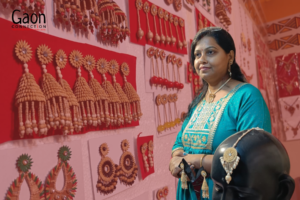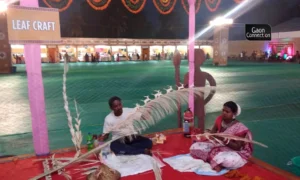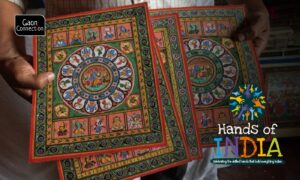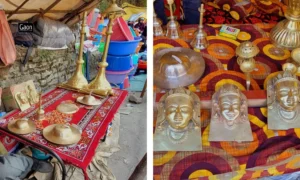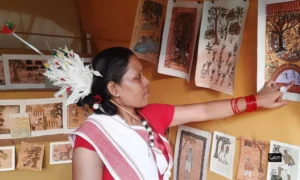I am visiting Dambulla Rock Temple which is a UNESCO World Heritage site. It is a cave temple complex with more than 80 caves. Five of these are open to the public to enjoy the immeasurable riches of Lord Buddha, related statues and paintings on the wall. What adds to the antiquity of the site is that the entire complex is almost 2,200 years old.
In hindsight, my attempt to briskly walk up the steps was rather ill-thought. I was panting and tired. I pause to rest and catch my breath.
“Slow, my friend, slow. You are no longer a teenager” — I tell myself. And truth be told, I had made such mental notes several times in the past few years, only to disregard them when in the vicinity of yet another tourist attraction. My eagerness to reach the site quickly has always overcome rational thought.
I meet an old lady somewhere midway on my three hundred odd steps ascent to the top of the rocky cliff. The old lady who sells flowers to visitors on the way up walks up to me, clutching a small bunch of blue lilies. She is smiling and saying something in her native language. I can only comprehend words — ‘Sir’, ‘flowers’ and ‘Buddha’.

The flower seller offers me five blue lilies which is a traditional offering to Lord Buddha — for two hundred Sri Lankan rupees (about Rs 45 in Indian currency). I offer fifty of those rupees but she mumbles something about her deceased husband and the children she has to support and we settle for a hundred. We chat for a while, and after slipping in another hundred to her, I walk ahead. She is overwhelmed. As I walk, she runs up and hands me two more flowers. this time lotus.
***
I had read somewhere that the caves here are prehistoric, and evidence of human settlements which is found is dated thousands of years.
After the arrival of Buddhism in Sri Lanka, these caves served as monasteries for the monks. The story goes that somewhere in the 100 BCE, when Anuradhapura was the country’s capital, the then-king Vattagamani Abhaya escaped the capital which Tamil intruders had invaded.
The Buddhist monks gave him shelter in these caves. Fifteen years on, the king regrouped his forces and recaptured his throne. To express his gratitude, he converted the cave where he took refuge into a Buddhist temple. In the following centuries, other kings enriched the caves with statues of Buddhas, Bodhisattvas and paintings. Some even had their figures installed!
***
I hardly see any tourists when I finally reach the top of the stairs —just a few usual hawkers peddling their wares. My companions would take a little while to arrive, and I have time on my hands.

The 45 feet long idol of sleeping Buddha almost seems too large for the cave.
The entrance to the cave temples is through a doorway in a tiled roof structure. I spot a notice board and hoping to glean some information, I walk towards it.
The notice board lists the Dos and Don’ts for visitors. If you have doubts about your destination, bullet point 1 clarifies: “Now you are entering a sacred place.” If you still don’t get it, the second point defines it even further: “This is Holy place” (sic). That now established; I find the third point quite intriguing. “Any religious person who belongs to he/she has a right to protect this sacred place.” Right or duty to protect? The he/she bit too is rather charming.
***
I am struck by the colossal rocky overhang which dominates the view as I enter the door. The five caves are under this massive chunk of rock. Our guide, Marcus, points to us the drip-ledge along the edge of the rock. This carving on the mouth of the rock was a piece of brilliant engineering. It prevents water from dripping into the cave’s interior thereby protecting its contents. And the contents inside the Dambulla cave temple have survived for more than 2,000 years.

The 45 feet long idol of sleeping Buddha almost seems too large for the cave. There is an expression of bliss on Buddha’s face as he reclines on the elaborate round pillow on his way to Maha Parinirvana. We are in Cave number 1, also called Devaraj Lena Vihara [lena in Sinhalese means a cave]. There is a seated Buddha as well near the feet of the sleeping Buddha with his favourite disciple Ananda standing next to him. The cave is full of rock paintings of Buddha. It is incredible to see them survive – relatively unscathed- for over two thousand years.
***
I find the second cave to be the most fascinating. It has a sleeping Buddha, and also dozens of beautifully carved seated Buddhas in different mudras [postures]. There is even a granite standing Buddha. What takes my breath away is the intricate artwork on the cave’s ceilings. Very beautifully painted, with natural dyes. Our old acquaintance, Vattagmani Abhaya, who found refuge in these caves, makes an appearance here. His painted wooden statue finds a place next to one of the seated Buddhas at the cave’s entrance.
***
The third cave is smaller than the second one but as elaborate. The ceiling has a thousand buddhas painted on it, making it attractive. There are Buddha statues, of course.
The fourth cave has an exciting feature, but I need to tell you a small story before I talk about it.

The contents inside the Dambulla cave temple have survived for more than 2,000 years.
When Vattagamani Abhaya fled the Tamil army with his two queens and son, the chariot seemed to be slowing down. In a singular act of selflessness and bravery, The younger queen, Somadevi, jumped off the chariot to help speed up the fleeing royal family. One of the Tamil chiefs eyes the beautiful young queen and gets her back to Tamil Nadu. After 15 years, when the king Vattagamani Abhaya wins back his kingdom, he makes it a point to retrieve Somadevi from the clutches of the Tamils. To commemorate Somadevi’s supreme gesture, the king built a small shrine – Chaitya – in the cave, and it is believed that the queen’s jewellery is buried here.
On the return walk down the stairs, I did not see the flower seller lady. It is dusk now; she would have wound up for the day. I am glad I bought the flowers from her; I offered a blue lily in each cave. And the two lotus flowers, you ask? An additional offering in gorgeous second and the third caves!







